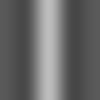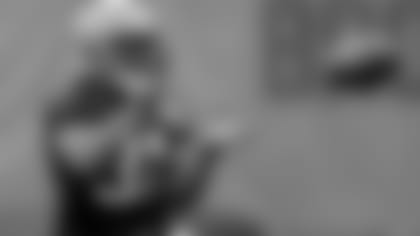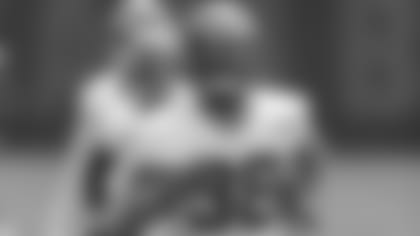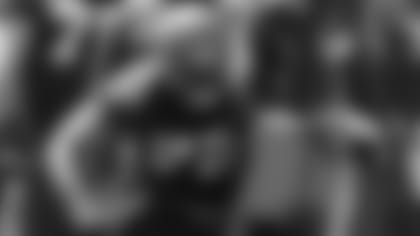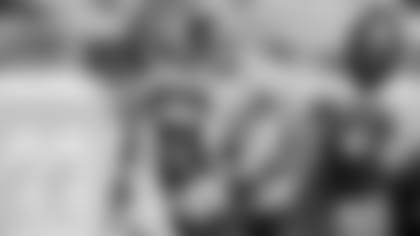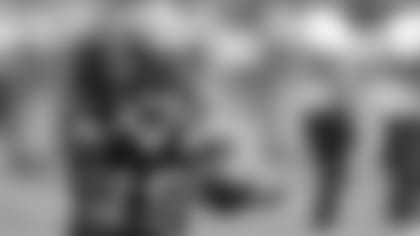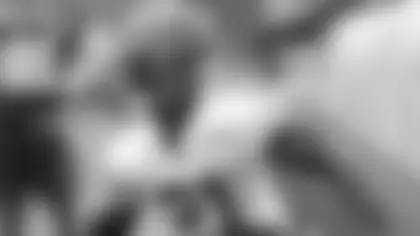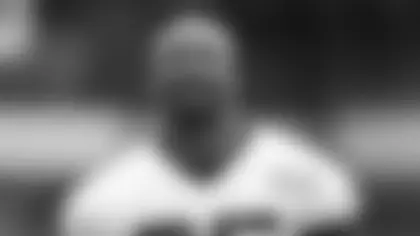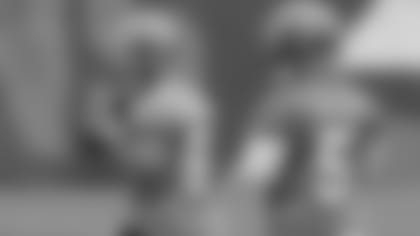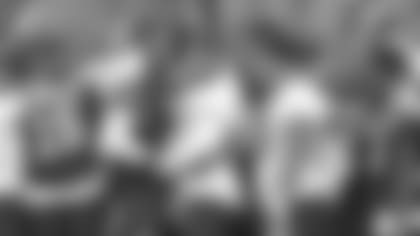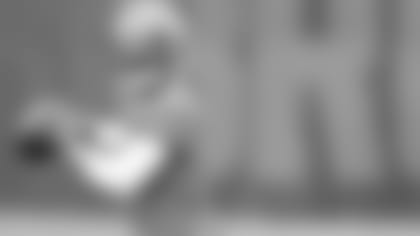On November 1, 1959, in a game against the New York Rangers, a puck hit Montreal Canadiens goalie Jacques Plante in the face. Plante was a veteran player who knew through years in the league that this shot would take him out of the game. Plante was not wearing a protective mask and the blow resulted in a deep gash between his eyes. It was not the first shot that took Plante out of a game, but he decided that it would be the last. Plante went to the locker room where a trainer stitched the cut, and he later returned to the game wearing a protective mask. It was the first time an NHL goalie wore a mask during a regular season game. (1)

On November 15, 1953, in a game against the San Francisco 49ers, an opponent's elbow struck Cleveland Browns quarterback Otto Graham in the face. Graham was a veteran player who knew through years in the league that this hit would take him out of the game. Graham was not wearing a protective mask and the blow resulted in a deep gash running down his cheek bone. It was not the first hit that took Graham out of a game, but he decided that it would be the last. Graham went to the locker room where a trainer stitched the cut, and he later returned to the game wearing a protective mask. It was the first time an NFL player wore a mask during a regular season game.
The two nearly identical plot lines would seem to make for a great coincidence in American sport. While Plante was the first to wear a protective mask in hockey, however, Graham was not his football counterpart. Nevertheless, print and online sources repeatedly name Graham as the person who ended what has been called the league's open-helmet era. He did not. And even with resources like the online museum Helmethut.com, discovering who did is a challenge. (2)
Helmet Hut has a deep collection of football helmets and masks with examples of improvised masks dating perhaps as far back as the 1920s. But these are pictures of masks, not pictures of players wearing them. With the masks removed from their historical context it's difficult to place their appearance on the football timeline. Lacking an accurate parallel to Jacques Plante's story, searching for dated references or images seems like a practical way to find football's facemask pioneer.
Respected collectors such as Helmet Hut, however, stress the difficulty in "tracing the evolution of football equipment…with any single date of accuracy." (3) There are too many variables and no absolutes, according to the site. The search is further complicated by perception. Football facemasks were prosaic. There were times when wearing a mask was newsworthy, but never to the extent in football as in hockey. Plante's mask brought anonymity to his reappearance. His mask was opaque fiberglass. It didn't merely protect his face; it obscured his identity. In the golden age of comic books and superheroes, a wounded Jacques Plante emerged from the locker room as a masked man—a Lone Ranger on skates. (4)
The early football facemask, meantime, wasn't a mask at all. It protected, but did not conceal. The mask was plain and practical, while Plante's was mysterious and memorable. Graham's mask stirred no intrigue or interest and the tangled facts regarding his mask were subsequently spun into football folklore.

How Graham came to wear a mask is a tale with many variations, but most of the stories point, accurately, to that game in 1953. It's also true that Graham was hurt in the first half and required fifteen stitches to close a cut on the side of his face. He returned in the second half wearing a plastic mask to protect the injury from further harm.
Graham's return was even accompanied by heroics. Back-up George Ratterman filled in during Graham's absence, but the team performed sluggishly under his leadership. The Browns improved once Graham returned, donning the facemask, at the start of the second half, and they went on to win, 23-21. It was Cleveland's eighth win in a row—a victory that not only preserved the Browns' perfect season but knocked the 49ers out of title contention as well.
The great comeback story, however, gets fuzzy beginning with the mask's design, often attributed to Cleveland head coach Paul Brown. Brown is said to have fashioned it during halftime of the 49ers game. Newspaper stories the next day paid little attention to the mask, which seems surprising for such a revolution in football equipment, especially one conceived, designed and developed within 12 minutes. (5) The New York Times covered the Browns-49ers game but said nothing about Graham's mask.
Writing for the Cleveland Plain Dealer, Harold Sauerbrei does say that Graham came back wearing a "plastic protective apparatus on the side of his helmet." However, a photograph from the game which appeared on the front page of a later edition of the Plain Dealer shows San Francisco linebacker Hardy Brown chasing Graham. Graham is wearing the "apparatus" Sauerbrei mentioned—but so too is Hardy Brown! So too is another 49er behind Hardy Brown! Unless coach Paul Brown decided, in an unprecedented display of sportsmanship after Graham's injury, to protect not only his star quarterback but a few members of that day's opponent as well, it's clear that Graham's mask was not the work of a whirlwind 12-minute improvisation. Furthermore, what legend recalls as innovative later proved problematic.
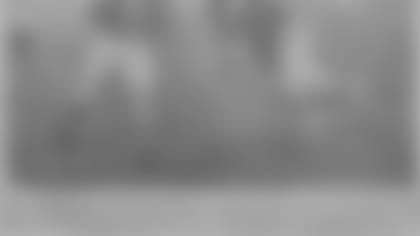
Both Graham's mask and Hardy Brown's were made of Lucite, a clear plastic material sold under different names, including Plexiglas. (The third player, whose number is obscured in the picture, is wearing a different type of mask.) There are some versions of the Graham story that omit Paul Brown, substituting a Cleveland assistant trainer as the mask's designer. Regardless of who was responsible, that person was likely soon ducking for cover rather than looking for credit. Although generically called "acrylic safety glass," Lucite was not safe for use as a football facemask. When it broke, it did so in dagger-like pieces that could cause more harm than the blunt force trauma the material was supposed to absorb. Lucite also becomes more brittle as the air temperature falls. Before the decade was out, the NFL would ban Lucite masks.
It would be unfair, at this point, not to return to Paul Brown's contributions to facemask development. The Lucite mask, though present, was not popular in the early 1950s. Cleveland apparently had the mask in their equipment stock when Graham was hurt against the 49ers. But Paul Brown was incubating his ideas about facemasks well before Otto Graham was hurt. He knew of Lucite's shortcomings and toyed with several alternative designs before finding success with his fourth model after the prototype.
That mask took the form of a rubber-coated steel tube shaped like a semi-circle that was bolted to each side of a helmet just below the ear holes. The mask was commonly called the single bar but was cataloged by the manufacturer as BT-5 (BT for Bar Tubular; the 5 referred to the number of generations needed to produce an effective model). The helmet company, Riddell, made the masks, but Brown held the patent. Otto Graham was among the first players to wear the single-bar beginning in 1954. The Otto Graham legend is perhaps the result of combining the Lucite mask story and the single bar story or maybe confusion that surrounds the two stories.
But the Graham fable is curious not only because it survives as part of the game's mythology, but also because it survives in spite of a factual story involving a different Cleveland Browns player.
Graham's injury in November of 1953 was accidental, sustained during the course of play. (6) But several seasons earlier on October 15, 1950, Pat Harder of the Chicago Cardinals slugged Len Ford of the Browns. Ford required surgery to repair a broken jaw and several broken teeth and was out for nine weeks, missing the remainder of the regular season and Cleveland's playoff game versus the New York Giants.
The incident was vicious, a sucker-punch that occurred after the play on an unsuspecting Ford. Nevertheless, Harder was not flagged. The officials did, however, call a holding penalty on Ford! NFL Commissioner Bert Bell also wired coach Paul Brown after the game instructing him to have Ford forward thirty dollars to the league as payment for a rough-play fine.
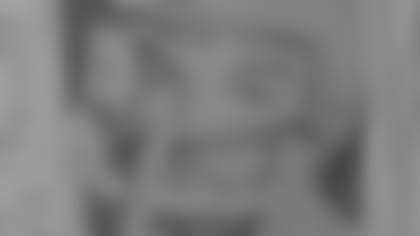
Paul Brown immediately defended his player, building a case that included game films and player testimony. Bell eventually withdrew the fine, but never took action against Harder. When Ford finally returned to action in the Browns championship game victory over the Los Angeles Rams, the headline in the Cleveland Plain Dealer the day of the game read, "Star End to Don Mask for Battle."
Examination of the historical record, however finds that Ford wasn't the only player wearing a mask in the 1950 NFL Championship Game.
A photograph from the game shows Otto Graham, number 60, running with the ball in a pair of black Converse Chuck Taylor high-top sneakers (but without a mask). (7) About four yards behind, approaching from Graham's right, is number 57 for the Rams, Don Paul. He wears a mask. That another player in that game was already wearing a mask shows that Len Ford's story was newsworthy more because of his comeback than his equipment. Paul's mask, incidentally, is not Lucite but looks like an early ancestor of today's masks. (It is in fact the same type of mask the unidentified player is wearing in the Otto Graham-Hardy Brown image from 1953.)
Another photo of Paul wearing a mask, from 1949, shows him barreling down on the aforementioned Pat Harder of the Chicago Cardinals. (8)
A 1948 image shows a member of the Chicago Bears looking on as Jim Castiglia of the Washington Redskins appears to cross the goal line. (9) Among the players identified in the picture is number 30, H. Allen Smith, who is wearing a facemask.
Yet another picture—also from 1948 and also showing Otto Graham—was taken just as Cleveland's Edgar Jones scored the first touchdown in the All-America Football Conference Championship Game against the Buffalo Bills. (10) Behind Jones in the image is Cleveland's Ed Ulinski, number 36, who is wearing a mask.

Masks were even present well before 1948, as a photo in which Byron "Whizzer" White of the Detroit Lions is being chased by an unidentified masked player reveals. (11) Though the image is undated, White is wearing 44, a number he had for only the 1941 season. In addition, photos from the Chicago Bears 73-0 championship win over the Washington Redskins in 1940 clearly show number 11, Ernie Pinckert of the Redskins, wearing a mask. (12)
In the 1938 championship game between the New York Giants and Green Bay Packers, rookie John Mellus, number 33 of the New York Giants, wore a mask. (13) Another image of Pinckert from a 1937 game against the New York Giants shows him with a mask looking on helplessly as Cliff Battles plunges over the goal line. (14)
All of the masks mentioned from 1937 to 1950 look to be the same type. Imagine the single-bar mask with a vertical bar attached at the midpoint that bows out slightly in an upward direction before arcing back to a part of the helmet just above a player's nose. There is a third component, an ellipse, attached below the horizontal bar. Turned upside down, the mask looks like a line drawing of an umbrella.
That the masks appear identical would seem to disqualify the possibility that each one was personally improvised. The masks, in fact, were designed by the Schutt company. Although Schutt didn't mass produce masks until the early 1950s, Helmet Hut indicates that it was common to experiment with equipment before beginning regular production.
"It's hard to field test a product if it's not on the field," according to an email response from the site's administrators.
Furthermore, since there wasn't a great demand for facemasks in the 1930s and 1940s, it didn't make good business sense to tool for production when there were enough prototypes to go around. Schutt Sports has a brief history on their website that in fact confirms the company produced their first football "face guards" in 1935.
Schutt, however, was not the first manufacturer of football masks. Paul Brown's development of the BT-5 sometimes leads to the mistaken belief that he invented the football facemask. Brown did invent the single-bar, but the city of Terre Haute, Indiana, claims to be home to the facemask's actual inventor, Vernon McMillan, an entrepreneur and former Terre Haute mayor who is buried in one of the city's two cemeteries. Beyond references to McMillan's company, McMillan Sports, producing facemasks beginning sometime in the mid-1930s, which actually coincides with the advent of Schutt's mask, other details about those masks are scarce, including what they looked like and who wore them.
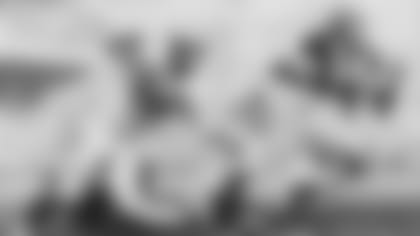
Again, as is the case with Paul Brown, it's more likely that McMillan, rather than inventing the facemask, invented a specific mask. Victor Football Goods ran ads in Sporting Life magazine touting the company's 1897 Victor Face Mask and Head Protector as having "many advantages over the old style." (15) Whatever that old style may have been, their existence dates to more than half a century before Graham wore a mask and decades before Schutt and McMillan made them. It also means that facemasks were available for players to wear well before the establishment of the National Football League.
As for who was first, until the next photograph is found that proves otherwise, that distinction goes to Ernie Pinckert from 1937.
BERT GAMBINI is a writer for the University at Buffalo. He previously worked over twenty years on-the-air at various Western New York radio stations. This article originally appeared in the September/October 2012 issue of The Coffin Corner, the official magazine of the Professional Football Researchers Association.
Notes
- Clint Benedict, a goalie for the Montreal Maroons, wore what is sometimes referred to as a mask for a few games in 1930. The "mask" was actually a leather noseguard designed for football players.
- www.helmethut.com
- Helmet Hut Letters. Worrell, Curtis and Jim Parker. June 1, 2011. Helmet Hut. September 6, 2011. www.helmethut.com.
- Consider how contemporary mentions of facemasks were nonexistent until Chicago Bears quarterback Jim McMahon started wearing a smoked visor. Another point is brought up by Todd Benault, Plante's biographer, who wrote that Plante's decision to wear a mask was met with disapproval by players, including many goalies. That sentiment kept the mask story alive well after the Rangers game.
- Plante's goalie mask was something he had packed with his equipment since 1956, having tested it for years in practice before wearing it in a game.
- After the game, Art Michalik, the 49er who hit Graham said, "I made a dive for Graham and hit him with my elbow. I hope he's all right. I certainly didn't mean to hurt him." After the game, Graham said, "I don't think he did it on purpose. Anything can happen in a game like that." Cleveland Plain Dealer, Monday, November 16, 1953, p. 1.
- The image was used across pages 97 and 98 of the book 75 Seasons, by NFL Properties. Paul is obscured in that particular reproduction because he appears in the photograph at a point where it spills across the binding from one page on to the other. This picture is quite common and can be found in many other sources.
- National Football League Properties. The NFL's Official Encyclopedic History of Professional Football. New York: Macmillan, 1977, p. 40.
- Smith, Robert. Illustrated History of Pro Football. New York: Madison Square Press, 1972, p. 167.
- Although the Browns were not part of the NFL in 1948, they would eventually join the league. I'm using creative license to include them in this search.
- Cope, Myron. The Game That Was: An Illustrated Account of the Tumultuous Early Days of Pro Football. New York: Thomas Y. Crowell Company, 1974, p. 161.
- Ibid., p. 180.
- National Football League Properties. 75 Seasons: The Complete Story of the National Football League, 1920-1995. Atlanta: Turner, 1994, pp. 44-45.
- Ibid., pp. 100-101.
- Sporting Life, 1897, Volume 29 Number 20


